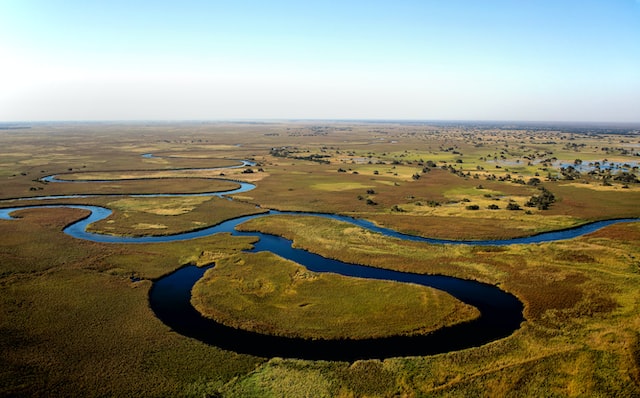The Okavango Delta is one of the most breathtaking ecosystems in the world, located in Botswana. This inland delta spans across 6,000 to 15,000 square kilometers, making it one of the most unique and diverse landscapes in Africa.
Fed by seasonal flooding from the highlands of Angola, the delta is a haven for an astonishing variety of wildlife. From mokoro safaris to helicopter rides, the Okavango Delta offers an unparalleled wildlife experience.
Here’s everything you need to know about this natural wonder, including the best time to visit and the top ways to explore it.
What is the Okavango Delta? A Brief Overview
The Okavango Delta is an inland river delta located in Botswana. It covers between 2,315 to 5,791 square miles (6,000 to 15,000 square kilometers) depending on the season, making it one of the most expansive inland deltas in Africa. Unlike most deltas that empty into oceans, the Okavango River floods the delta, creating a rich wetland teeming with life.
Annually, approximately 11 cubic kilometers of water flow into the delta from the Angolan highlands, peaking between March and June. Unlike other African deltas that have been ravaged by human activity, the Okavango Delta remains a pristine wildlife haven.
The Okavango Delta’s Significance as a Natural Wonder
Though not the largest delta in Africa, the Okavango Delta holds the distinction of being one of the most intact and unspoiled.
Its waters support a variety of ecosystems, from seasonal floodplains to permanent marshes, creating a paradise for wildlife.
Recognized as one of the “Seven Natural Wonders of Africa,” it stands as a reminder of what other inland deltas once were before being devastated by human activity.
In 2014, it became the 1,000th site to be listed as a UNESCO World Heritage Site, further highlighting its global importance.
Wildlife of the Okavango Delta: Home to the Big Seven
The Okavango Delta is home to an extraordinary range of wildlife, including the renowned “Big Seven”: elephants, lions, leopards, rhinos (both black and white), buffaloes, hippos, and crocodiles.
This biodiversity hotspot also boasts rare species such as the African wild dog, which has one of the most thriving populations in Africa within the delta.
Additional notable species include giraffes, zebras, kudus, and over 400 species of birds, making it a paradise for birdwatchers.
The African Fish Eagle, with its striking appearance and haunting call, is one of the most iconic avian residents of the delta.
Exploring the Okavango Delta: Safari and Adventure Options
There are several ways to explore the Okavango Delta, each offering unique experiences.
- Mokoro Safaris: The traditional mokoro (a dugout canoe) safari is one of the most serene ways to explore the waterways of the delta. Navigated by a guide using a pole, mokoro safaris allow for close-up wildlife encounters without disturbing the environment.
- 4×4 Game Drives: While mokoro safaris provide a peaceful, intimate experience, 4×4 game drives are another popular way to explore the delta. These drives allow visitors to cover more ground and witness wildlife in different regions of the delta. Some private game reserves also offer off-road drives for a closer look at the animals.
- Walking Safaris: For those looking for an immersive experience, some private reserves within the delta offer guided walking safaris. These excursions provide a closer, more grounded perspective of the environment, offering the chance to observe animal tracks and smaller species that may be missed from a vehicle.
- Helicopter Rides: For a bird’s-eye view of the delta’s immense size and landscape, helicopter tours are an excellent option. Though less intimate for wildlife encounters, they offer spectacular views of the delta’s expanse and the animals that inhabit it.
Okavango Delta Weather: What to Expect Year-Round
The weather in the Okavango Delta is highly variable throughout the year. The floodwaters typically begin arriving in March and continue to rise until the peak months of June through August.
These months also coincide with Botswana’s dry season, which brings pleasant, cooler temperatures of around 82°F (28°C) during the day. However, the nights can get quite cold.
From December to February, the region experiences hot, humid weather with temperatures nearing 100°F (40°C) and occasional rainfall. October is considered the hottest month, with temperatures exceeding 100°F, making it less comfortable for outdoor activities.
Best Time to Visit the Okavango Delta
The best time to visit the Okavango Delta is during the dry season, which spans from June to August. This period offers the most comfortable weather conditions and coincides with the peak of the delta’s floodwaters, attracting a diverse array of wildlife from across Africa. The high concentration of animals, including predators, makes for an exciting safari experience.
During these months, visitors can expect to see over 200,000 large mammals congregating around the delta, including herds of elephants, buffalo, and antelope.
Photography Tips for Capturing the Okavango Delta
For photographers, the Okavango Delta offers stunning opportunities to capture wildlife and landscapes. To get the best shots, it’s recommended to:
- Use a long lens to photograph wildlife from a distance.
- Bring a wide-angle lens to capture the expansive views of the delta.
- Take advantage of early morning and late afternoon light for softer, more dramatic photos.
A multipurpose telephoto lens, such as an 18-200mm, is ideal for mokoro safaris, where changing lenses can be challenging due to space constraints. Whether capturing intimate moments with animals or the delta’s sweeping landscapes, preparation is key for a successful shoot.
References:
